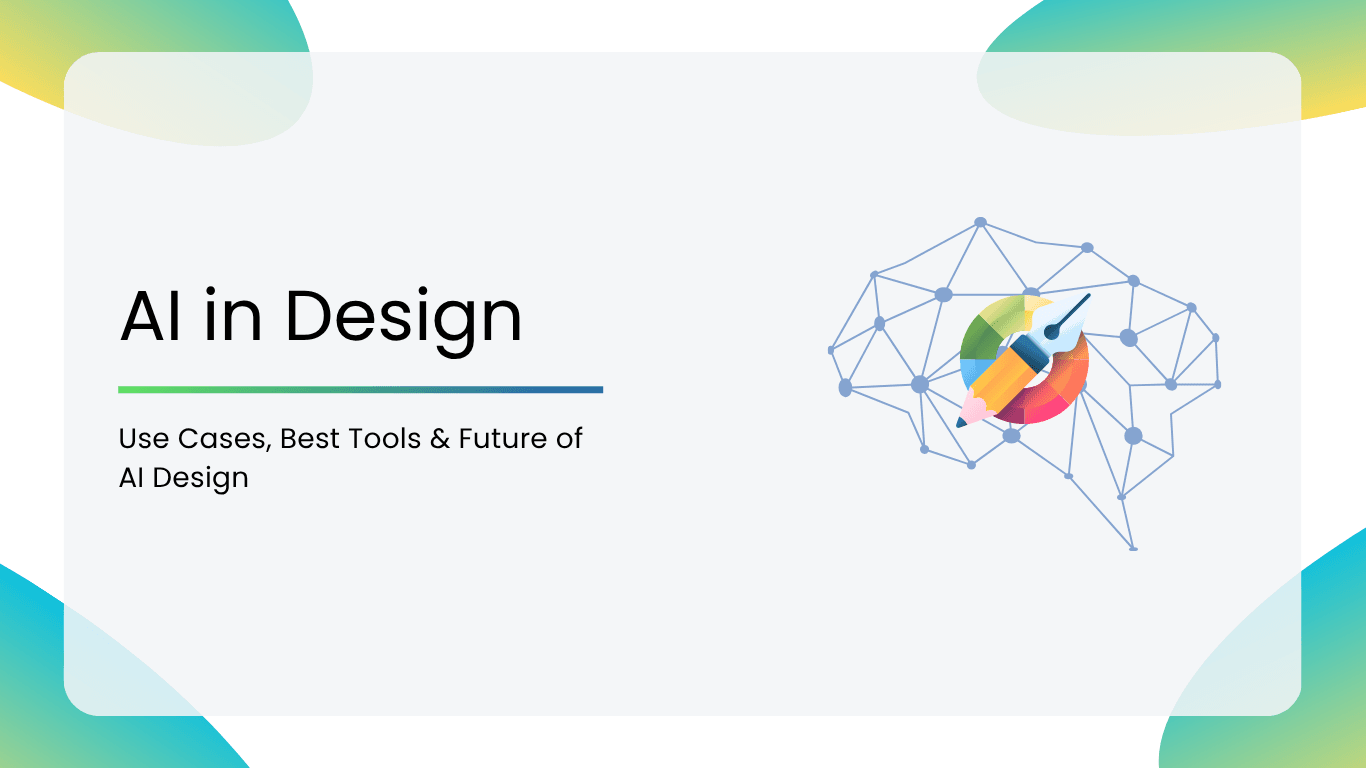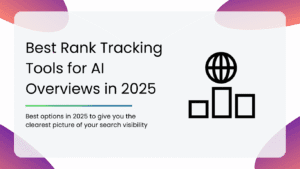Design has always been about imagination – filling empty spaces and making them into powerful images that communicate more than words. But what if machines started imagining with us? With the help of AI, not as a tool but as a design collaborator. From choosing colours with uncanny accuracy to creating entire websites in seconds, AI is changing the face of design. What once used to be sketched, tested, and refined for hours can now be imagined, changed, and perfected in a flash. But don’t worry, designers aren’t being replaced, but they are being supercharged! This isn’t the future; it’s already happening.
Now let’s see how AI is transforming the design process today and what it means for the future of design.
How is AI Being Used in Design
- Automatic Layout Generation: AI tools such as Canva, Wix, and Adobe Firefly make it easy to create something that looks aesthetically pleasing without much effort. These platforms use AI to design elements in a smart way, saving time on manual design decisions.
- Logo & Branding Design: Design tools such as Looka or other tools use AI to create complete brand kits such as logos, fonts, colour, etc., based on a few simple user information, such as company name and style preferences.
- Illustrations & Generative Art: With tools such as DALLE-E- E, Runway ML, or Midjourney, designers can create unique art, images, and textures by simply writing out a description. This is revolutionizing concept art, marketing visuals, and even storyboarding.
- UI/UX & Web Design: AI-based software like Uizard and Framer AI can turn sketches into working designs. Some tools even analyse user behaviour to suggest UX improvements or generate A/B test variants automatically.
- Smart Colour & Font Suggestions: Tools such as Khroma and ColorMind use machine learning to suggest colour schemes based on emotions, industries, or trending styles. Other AI tools also consider brand identity to suggest matching fonts and styles.
- Image Enhancement & Editing: AI is used to remove backgrounds, enhance photos, correct lighting, and even swap styles with platforms such as Remini, Adobe Sensei and Let’s Enhance.
Pros and Cons of Using AI in Design
| Pros | Cons |
| Speeds up workflows | Limits Creativity |
| Boosts Personalization | Copyright/IP issues |
| Enables easy collaboration | Risk of Over-reliance |
| Offers idea generation | Gives a generic output |
| Accessible to non-designers | Skill gap still exists |
| Scales across platforms | Can raise ethical concerns |
Real World Use Cases of AI in Design
Sephora – AI in Beauty & Product Design
- Virtual Try-On & Product Visualisation: Sephora uses AI and AR to develop an interactive virtual experience through which customers can virtually try on lipstick, foundation, and eye makeup online. This design innovation transforms static product images into real-time, dynamic imagery, bringing UI/UX design to life throughout their app and in-store screens.
- Skin Colour Matching Tool: Their AI-driven “Colour iQ” technology is used to assist with creating personalised skincare and foundation matching experiences. It analyses facial features and provides personalised product suggestions, which is a huge step in UX personalisation design.
H&M – AI in Fashion & Visual Content Design
- AI-Generated Fashion Models: H&M uses AI-generated digital avatars, or “digital twins”, for lookbooks and photo shoots. It reduces the cost and effort required to produce content. The avatars are used for visual campaign creation on H&M’s websites and apps.
- Designing Fashion with AI Predictions: H&M uses AI to forecast trends and co-design clothing lines. The AI analyses Pinterest/social media trends and customer information, helping design teams to create patterns, colours, and styles that align with market demand.
Nike – AI in Product Customisation & UX Design
- Nike Fit – Foot Scanning UX Design: Nike uses an AI-based foot scanner app called Nike Fit that uses AI to scan the feet of customers and recommend shoe sizes. This technology was created to improve the user experience in finding the right fit, making it more efficient and accurate to buy shoes online.
- AI-Driven Custom Shoe Design: Nike also introduced the “Nike By You” initiative. Customers can co-create shoe designs through the use of AI, which recommends colours, styles, and components based on personal behaviour and preferences.
Zara – AI in Fashion Design & Trend Prediction
- AI-Assisted Product Design: Zara uses AI to scan customer comments, activity in the stores, and social media trends. Based on this information, designers are able to create collections quickly by concentrating on what customers are likely to desire. AI tools generate suggestions for fabric choices, silhouettes, and colours.
- Dynamic Visual Merchandising: Zara uses AI to produce window displays and store layouts based on what individuals within the region purchase. This allows visual design to adapt to changing trends in real time, thus becoming more captivating.
Best AI Design Tools in 2025
Best AI Design Tools in 2025
| Table of Contents |
| 1. Khroma |
| 2. AutoDraw |
| 3. Looka |
| 4. Synthesia |
| 5. Descript |
| 6. Designs |
| 7. Lets Enhance |
| 8. Canva |
| 9. Runway ML |
| 10. Adobe Firefly |
| 11. Figma |
| 12. Midjourney |
1. Khroma
Khroma is an AI-based colour palette web application that uses machine learning to learn your colour preferences and generate distinct colour palettes based on your design sense. It is a powerful design tool for designers, marketers, and branding professionals who need to present a consistent visual identity across all media.
Key Features
- Personalised Colour Palettes: The tool lets you choose your favourite colours, and Khroma’s AI will create a personalised palette that reflects your style.
- Instant Colour Pairing: Khroma automatically gives you colour suggestions that work well together for smooth design.
- Colour Extraction From Images: You can upload an image, and Khroma can extract the best colours for you to use in your projects.
- Web-Friendly Colour Codes: The tool lets you get HEX, RGB, and HSL codes to easily apply your colour schemes to websites, graphics, and branding.
- Infinite Colour Inspirations: The tool has a lot of AI-generated colour schemes for branding, UI/UX, and digital content.
Pros
- It generates personalised colour palettes based on user preferences.
- It also offers instant colour pairing suggestions that match well together.
- The tool extracts colour schemes directly from uploaded images.
- It provides HEX, RGB, and HSL codes for easy implementation in digital projects.
- It gives access to infinite AI-generated palette combinations for various design needs.
Cons
- The tool is limited to colour use only and is not a complete design tool.
- It might require a bit of training time to “learn” your preferences.
Review:
Khroma is a niche yet powerful tool for colour lovers and branding professionals. Once it adapts to your taste, it becomes an intuitive colour companion that helps you in building visually striking and cohesive designs.
2. AutoDraw
AutoDraw is an AI tool created by Google that converts rough doodles into refined, professional-looking images in real-time. Whether you’re brainstorming ideas, designing quick illustrations, or simply having fun, AutoDraw makes sketching easy for everyone, even those with no artistic skills.
Key Features
- Interactive Doodling: AutoDraw lets you express your creativity. Start doodling anything you want, and then see the AI guess and provide you with images that are connected to what you doodled instantly.
- Simple Integration: It lets you directly insert your chosen image into the artboard with a simple click.
- Customisation: AutoDraw allows you to customise your work the way you want it. You can resize images you insert, select colours using the built-in colour chooser, insert text, and insert shapes to make your work look more beautiful.
- Download & Share: Once you’re done with the creative process, the tool allows you to download your work in various formats, and you can easily share your work with the world.
Pros
- It converts rough doodles into clean, professional illustrations instantly.
- It gives interactive AI suggestions to improve user creativity and output.
- It has a simple click-to-insert functionality that streamlines the drawing process.
- It also allows resizing, colour selection, text, and shape insertion for better customisation.
- The tool supports downloading and sharing in various file formats.
Cons
- It has limited customisation options compared to professional tools.
- The tool is best suited for basic, quick sketches, not detailed artwork.
Review
This tool feels like having an AI-powered sketch assistant that instantly polishes your doodles. It’s fun, fast, and surprisingly smart as well, though the tool might not be ideal for advanced creatives.
3. Looka
Looka is an AI tool that simplifies the process of creating a brand identity from scratch with its AI-driven logo maker and branding suite. It provides a full branding kit that includes social media assets, business cards, website designs, and more. It’s an all-in-one solution for businesses looking to establish a professional brand identity quickly.
Key Features
- AI-Logo Design: Just by entering the company name and industry, Looka displays unique logo concepts.
- Full Brand Kit: The tool lets you purchase business cards, social media assets, and brand guidelines from your chosen logo.
- Customisation Tools: It also lets you adjust colours, fonts, and layouts to your brand.
- High-Resolution Downloads: Using Looka, you can easily download logo files in multiple formats such as PNG, SVG, and PDF.
Pros
- It creates logo concepts instantly based on the company name and industry.
- It includes a full brand kit with business cards, social media assets, and more.
- It lets you customise colours, fonts, and layouts easily.
- It provides high-resolution downloads in multiple formats like PNG, SVG, and PDF.
- It’s suitable for non-designers looking to launch a brand quickly.
Cons
- Not all logo concepts feel entirely unique or custom.
- Access to the full brand kit and downloads requires payment.
Review
Looka is an ideal tool for startups and small businesses that are looking for quick, professional branding. While the designs may lack deep originality, the ease and speed that they offer make them a great tool for beginners..
4. Synthesia
Synthesia is an AI tool that revolutionises corporate video production by replacing human actors with AI avatars. It is used by 35% of the Fortune 500 companies and is perfect for training videos, product demos, and multilingual communications without any filming equipment.
Key Features
- 140+ AI Avatars: The tool offers 140+ AI avatar characters with diverse ethnicities, ages, and professional appearances.
- Lip-Sync Technology: It has lip-sync technology that matches mouth movements to 120+ languages.
- Custom Avatars: The tool also lets you customise or clone your likeness.
- PPT/Voiceover Sync: The tool gives you the option to upload slides in order to create narrated videos with its AI capabilities.
Pros
- It offers 140+ realistic AI avatars with diverse appearances.
- It supports over 120 languages with accurate lip-syncing.
- It allows you to create custom avatars or clone your own likeness.
- It lets you sync AI narration with your PowerPoint slides.
- It removes the need for filming, cameras, or actors in video creation.
Cons
- Some AI avatars may feel slightly robotic in expression.
- Custom avatar and premium features can be relatively expensive.
Review
Synthesia transforms how businesses create training and communication videos. With AI avatars doing the talking, it cuts production time and cost as well. Though it still has some improvements to make.
5. Descript
Descript is an AI tool that redefines audio/video editing by treating media like a text document. Podcasters and interviewers can easily edit recordings by cutting and pasting words in a transcript, overdubbing mistakes, and removing filler words automatically.
Key Features
- Text-Based Editing: It deletes ‘ums’ in the videos by erasing transcript texts.
- AI Voice Cloning: The AI voice cloning re-records flubs by typing corrections.
- Studio Sound: It provides studio sound by removing any background noise and echo.
- Screen Recording: It captures tutorials with a webcam overlay.
Pros
- It lets you edit audio/video just by editing the transcript text.
- It automatically removes filler words like “um” and “uh.”
- Its voice cloning feature allows you to type corrections instead of re-recording.
- It offers studio-quality sound enhancement and echo removal.
- It includes a built-in screen recording tool with webcam support.
Cons
- It may take a little time to get used to the transcript-based interface.
- Voice cloning results can occasionally sound less natural.
Review
Descript simplifies audio and video editing like never before. Ideal for podcasters and educators, it offers precision and convenience, turning editing into a clean, text-based experience.
6. Designs
Designs is a versatile design tool that makes use of the capabilities of AI to simplify the graphic design process. With an intuitive and creative platform, it helps marketers aiming to bring their visual ideas to life seamlessly. From crafting engaging social media graphics to developing comprehensive marketing collateral, this tool stands out as a powerful tool in the world of graphic design.
Key Features
- Drag-and-Drop Design Feature: The tool has a user-friendly interface with intuitive drag-and-drop functionality.
- AI-Driven Design Suggestions: The tool provides AI-driven suggestions, improving the creative process.
- Templates for Various Marketing Materials: It offers a diverse range of templates for different marketing needs.
- Collaboration & Sharing Options: Marketers can collaborate seamlessly within the platform, and sharing options help make teamwork more efficient.
Pros:
- It features a user-friendly drag-and-drop interface for easy design.
- It provides AI-powered design suggestions to boost creativity.
- It includes ready-to-use templates for marketing, social media, and more.
- It enables smooth collaboration between team members on the platform.
- It offers one place to create, edit, and share marketing content efficiently.
Cons
- It offers limited customisation control compared to advanced tools.
- Some templates may feel generic if not tailored carefully.
Review
Designs.ai is a great fit for marketers who need to create visuals quickly without diving into complex software. While not built for pixel-perfect control, it’s a creative productivity booster for teams and solo creators alike.
7. Let’s Enhance
Let’s Enhance is an image enhancement tool that is developed through AI-powered deep learning, intended for upscaling and improving the quality of images. It is one of the valuable resources marketing managers can count on to uplift the visual impact of their graphics and photographs.
Key Features
- AI-Powered Image Upscaling: Let’s Enhance uses AI to upscale and improve the quality of images for a more professional appearance.
- Noise Reduction & Enhancement: The tool offers noise reduction facilities as well as detail enhancement in an image.
- Batch Processing for Efficiency: Marketers can process multiple images at once, saving time and improving workflow efficiency.
- Easy Integration with Well-Known Design Tools: The tool easily integrates with popular design tools to ensure compatibility with established workflows.
Pros
- It upscales images using AI while preserving high quality.
- It removes noise and enhances fine details automatically.
- It allows batch processing of multiple images for faster workflows.
- It integrates easily with popular design tools and platforms.
- It’s ideal for improving marketing visuals without manual retouching.
Cons
- The free version has limited export resolution and features.
- The tool is not suitable for extremely low-resolution images that require creative upscaling.
Review
Let’s Enhance is a must-have for marketers and designers who are looking to upgrade image quality without hiring a retoucher. It handles bulk images with ease, but the best results come with high-resolution inputs and a paid plan.
8. Canva
Canva is an AI-powered platform that extends its design simplicity to video, offering drag-and-drop tools for marketers and social media managers. Its strength lies in branded templating and quick turnarounds.
Key Features
- Magic Resize: It automatically adapts videos for reels, YouTube, and much more.
- Brand Kit: It offers a brand kit where you can apply logos, fonts and colours consistently.
- AI Background Remover: It has an AI background remover feature that detaches subjects from backgrounds.
- Template Library: There are 5000+ customizable video designs available for editing in the tool.
Pros
- It simplifies design with a drag-and-drop interface and smart templates.
- Its Magic Resize tool saves time by auto-adjusting for different platforms.
- It features AI-powered tools like background remover and text-to-image.
- It includes brand kits to maintain design consistency across teams.
- It offers a massive library of templates and visual elements.
Cons
- It has limited flexibility in advanced design or animation compared to Pro Tools.
- Team collaboration features are locked behind premium plans.
Review
Canva is the ultimate design tool for marketers, especially non-designers. Its AI tools speed up social content creation, though serious creatives might still need something more robust for complex visuals.
9. Runway ML
Runway ML is a powerful AI-driven creative suite that allows marketers, designers, and content creators to edit videos and images and even generate animations without any advanced technical skills.
Key Features
- AI Video Editing: It generates and edits videos easily using AI-powered tools.
- Background Removal: The tool lets you remove or replace the background in images and videos with ease.
- AI Art & Animation: It transforms static images into animations and improves creativity in just a few clicks.
- Collaboration Features: It also lets you work with your teams and sync projects in real-time without any hassle.
Pros
- It enables AI-based video editing with minimal technical knowledge.
- It lets you remove or replace backgrounds in videos with a click.
- It turns static images into motion graphics and animations.
- It allows team collaboration with real-time syncing.
- It offers cutting-edge features for experimental and artistic content.
Cons
- It requires a learning curve to explore the full toolset.
- The processing of the tool can be slower on large projects, depending on your plan.
Review
Runway ML feels like the Photoshop of AI-powered video, that is creative, intuitive, and designed for experimentation. Great for social media creatives and storytellers, though power users will want to explore its advanced settings.
10. Adobe Firefly
Adobe Firefly is a revolutionary web application that is driven by generative AI and offers users the ability to realise their personal and imaginative creative ideas with ease and convenience. It lets you venture into a rich and thrilling world of unlimited possibilities, from creating photorealistic portraits to interactive text effects.
Key Features
- Simple Prompts: It lets you create straightforward prompts in over 100 languages for diverse creative projects.
- Text to Image: You can easily generate detailed images from textual descriptions.
- Generative Fill: It seamlessly removes or introduces objects with a brush tool.
- Text Effects: You can apply unique styles and textures to words and phrases.
- Generative Recolour: It lets you create multiple colour variations of vector artwork effortlessly.
- 3D to Image: It generates images by interactively positioning 3D elements.
- Extent Image: The tool also adjusts image aspect ratios with just a single click.
Pros
- It supports simple, multilingual prompts to create stunning visuals.
- It turns text descriptions into detailed images quickly.
- Its generative fill and recolour tools enhance editing speed.
- It offers unique text effects and 3D-to-image capabilities.
- It integrates well into Adobe’s larger Creative Cloud ecosystem.
Cons
- The tool is still evolving, not all features are available in non-beta tools.
- It requires a Creative Cloud subscription for full integration and export.
Review
Adobe Firefly is Adobe’s bold leap into AI design that blends familiar tools with powerful generative magic. It’s ideal for creatives who want artistic control with the help of AI, though its best tricks are still maturing.
11. Figma
Figma is a leading cloud-based interface design and prototyping tool, now enhanced with AI capabilities. Figma is globally known for team collaboration, where teams are able to design, test, and iterate on work together. With the introduction of AI, the entire creative process has become faster, smarter, and more intuitive.
Key Features
- AI-Powered Design Suggestions: It rapidly generates UI designs, component variations, or entire screens from simple prompts, thus saving hours of manual work.
- Smart Content Autofill: It lets you replace placeholder text, create product names, or generate microcopy with AI-suggested text that is both context and tone matched.
- Dev Mode: It automatically generates concise code snippets and documents that developers can leverage from design files to speed up handoff.
- AI Design Assistant: It gives instant feedback, accessibility, and best design practices at your fingertips while designing interfaces.
- Version Control & Collaboration: The AI tracks design modifications, resolves conflicts and even summarises modifications.
Pros
- It provides AI suggestions for UI design, screens, and component variations.
- It offers smart text autofill for UX content and microcopy.
- It generates clean, developer-ready code snippets from designs.
- It includes an AI assistant for design best practices and accessibility tips.
- It tracks changes and resolves version conflicts collaboratively.
Cons
- AI features are in early stages and might require refinement.
- Some premium features are restricted to enterprise plans.
Review
Figma, with the help of AI, transforms the design workflow into something smarter and smoother. It’s perfect for teams building digital products rapidly, and the AI assistant is a quiet but powerful design partner.
12. Midjourney
Midjourney is a powerful AI tool that creates images from text. It is used by designers, art directors, marketers, and branding teams to quickly experiment with creative ideas, visual directions, and campaign concepts.
Key Features
- Text-to-Image Generation: Midjourney lets you write a description and creates new images such as product designs, fashion sketches, and imaginative branding pictures.
- Artistic Style Customisation: It lets you select from a wide range of styles or just create your own.
- Rapid Prototyping for Visual Concepts: It generates dozens of variations instantly, which is ideal for brainstorming or pitching visual directions.
- Community & Discord Integration: It lets you collaborate, tweak, and remix images within a shared Discord server.
- Commercial Licensing: It offers paid plans that include rights for business use, making it safe for professional and commercial projects.
Pros
- It creates highly detailed images from simple text prompts.
- It offers a wide selection of artistic styles and creative directions.
- It rapidly generates variations, making it ideal for brainstorming.
- It integrates with Discord for fast-paced collaboration and remixing.
- It provides commercial rights for business-safe use.
Cons
- It requires familiarity with Discord to navigate easily.
- The output might require post-editing to match brand guidelines.
Review
Midjourney is a visual wonder machine for branding teams, designers, and artists. Its AI-generated images are rich and bold. However, the tool is only great in helping to polish results before final use, especially for client-facing content.
Future of AI in Design
- Generative Co-Design Will be the Norm: AI not only will assist in creating assets but also collaborate with designers in real-time. AI can start brainstorming with you soon, providing you with lots of smart design ideas that are ideal for your brand instantly.
- Design Becomes More Inclusive & Accessible: AI can detect and correct bias in photos, improving branding, UX, and product photography for all. Additionally, AI-powered checking tools will assist teams in crafting products that resonate with all from the very beginning, not just through an audit.
- From Static Assets to Dynamic, Personalised Design: In product and marketing user interface, AI will enable content to be personalised to each individual in real-time. Imagine emails, websites, or packaging that change based on user data, with AI generating each version.
- Automated Branding & Identity Design: Startups and small companies will employ more AI to generate entire brand kits like logos, colour palettes, fonts, and social templates, from just a business name and description. Human designers will leave the initial designs to AI and focus on perfecting the finer aspects.
- Cross-Reality Design (AR/VR/XR): As the metaverse and spatial computing expand, AI will play a key role in 3D design for immersive spaces. Generative tools will help teams to create environments, avatars, and objects for virtual stores, experiences, and digital twins with no coding expertise.
AI is no longer just a futuristic concept in design, it’s a practical tool that is reshaping how we think, create, and deliver visual experiences. From faster workflows to smarter and more personalised visuals, AI gives designers the time to focus on what really matters: creativity, strategy, and impact.
As leading brands are already embracing AI in their design ecosystem, it’s clear that the future belongs to those who blend human creativity with machine intelligence.
The future of design isn’t human vs. machine – it’s human + machine.
Want to know more about different AI tools? Read our blogs:-
- Top 15 AI Video Generator Tools
- Top 15 AI Logo Design Tools
- 10 Creative AI Design Assistant Tools for Marketers
- 20 Best AI Marketing Tools to Improve Marketing ROI
FAQs
It depends on usage. Ethical design includes crediting sources, avoiding biased datasets, and using tools that respect copyright.
Basic design knowledge helps, but most tools are beginner-friendly.
It depends on your goal. Research and make use of the free trials before committing to any paid plans.
Follow design blogs, AI newsletters, YouTube channels and communities to stay updated.





